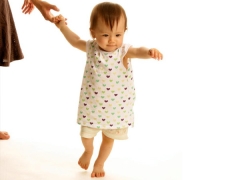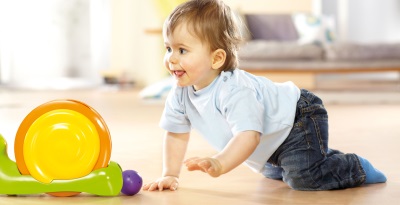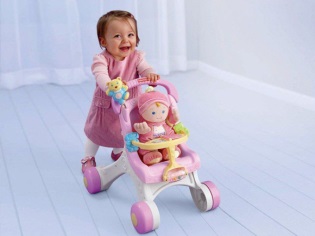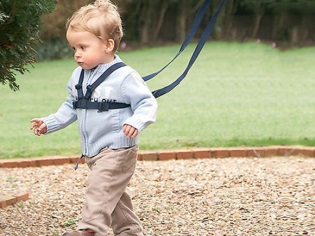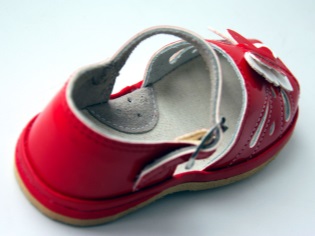How to teach a child to walk?
The first steps of a normally developing child are observed by happy parents at the age of 9-18 months And if you look at these terms of the beginning of walking in children, it becomes clear that this is a very individual skill. So there is no single standard for all babies.
In practice, many children develop according to the norms described in the pediatric literature - first they learn to crawl, then they stand on their feet in the crib, move around, holding on to the sides of the playpen and furniture, and finally make the first steps without support. But there are also many kids skipping the crawling stage and starting to walk almost immediately after mastering the skill of sitting.
And the answer to the question of young mommies about the start of walking of their babies will be “the child starts walking when it becomes sufficiently developed for this skill”.
How many months do children start walking?
Most of the babies take the first independent steps at the age of 12-15 months. In this case, there are children who begin to walk at the age of 9 months, and there are completely healthy babies who commit their first steps in 18 months and later.
There are many factors that affect the age at which a child goes:
- If the baby has started to take the first steps and is sick, then this may postpone his attempts at self-walking.
- If the first attempts at walking were accompanied by painful falls, this can also affect the speed of learning to walk.
- More frisky and active kids learn to move on two legs before the first birthday. Sophisticated and leisurely toddler begin to walk later - after a year.
- If the child is large, then he usually takes the first steps later than a thin baby, since it is harder to physically hold your body when walking.
- Kids with a calm temperament also learn to walk later, because they have not hesitated for a long time to abandon the crawling method they have tested.
See the next video for more details.
8 months - not too early?
Such a question is often asked by mothers whose children try to walk earlier than their peers. Note that the child’s body can withstand considerable loads, if the child’s development stages go on their own, that is, no one pushes him to sit or walk. In children who take their first steps, legs may begin to bend, but age does not affect this problem.
It is not very good if the child missed the crawling stage and at 8-9 months he immediately began to climb legs and take steps. Pediatricians call crawling a very useful stage, because it strengthens the muscles. A baby who crawls a little has an increased risk of developing lordosis, kyphosis and scoliosis, because his muscles may not be prepared for walking. So parents should support the developmental stages of the development of the child's musculoskeletal system in the first year of life.
When to sound the alarm?
Even if your child is a cheerful and cheerful peanut, and also actively crawls, if he has already turned 15 months old, and he has not begun to walk, it is worth going with a crumb to consult specialists.
If the baby is already 18 months old, but he never started walking, you should definitely go to the orthopedist and the neurologist.
How to strengthen the muscles of the legs?
A child can take his first steps later if he doesn’t have enough strong leg muscles or there is hypertonus (the legs are very tense and the baby doesn’t get on the entire foot, but is lifted up on tiptoe). If you have hypertonia, you should consult a doctor, but special exercises that can be done at home will help strengthen your muscles and improve coordination.
Exercises:
- To consolidate the ability to stand on their own Sit the baby face down on your haunches and, holding the baby by the hips, rock the baby back and forth. This will force him to stand on even feet. You can start doing this from the age of 9 months, but if the baby is not in a hurry to get up while rocking, it means that he still has weak leg muscles and such an exercise should be postponed for now.
- To develop coordination, from 6 months you can practice fitball (let the ball be medium in size and not completely inflated). Having put the baby on the fitball face away, hold the child tightly by the hips and tilt it in different directions.
- When the baby has learned to get up with the help of a prop, stimulate the consolidation of this skill with the help of a favorite toy. Move the toy on the floor (the baby will crawl behind it) to the chair, and then lift it up so that the crumb wants to climb to the toy, clutching the chair.
- You can “walk” with a baby older than 9 months using two sticks or a hoop. Taking two sticks about 1.2 m in height, let the standing child grab them and place your hands on his hands. Then slowly move forward, moving the sticks as if they were ski. If it is decided to use a hoop, have the child be inside and you are outside. Start moving the hoop forward, backward, in a circle. So you will push the crumbs to the movement.
- If the child already knows how to move around the room, holding your hand, teach him to step over the obstacle. Such an obstacle can be a rope or cord at the level of the knees of the crumbs. Pulling the rope between the furniture, bring the baby to her and offer to step over.
- If the child has already learned to step on the legs when the adult holds his hands (usually at 9-10 months), have the child hold onto the stroller or toy carriage. As soon as the stroller starts moving, the child will reach for it and begin to walk. Support the stroller so that it does not go far from the child. The best option is a walker.
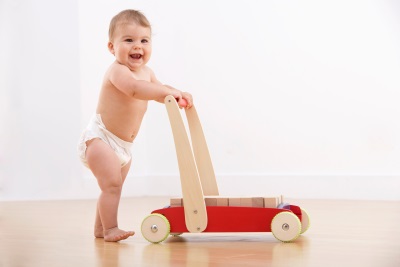
First steps - recommendations
- You should not put the baby on the legs, if his body is not yet ready to walk.
- It is important to encourage the movement of the crumbs. Do exercises with the kid, write it down to the pool, practice at home with the fitball, encourage crawling.
- While the baby is learning to walk along the support, think about where it will be most secure. Let the baby "train" next to the ottoman, sofa or other durable furniture.
- It is advisable to teach your child to walk at home without shoes and socks. Walking barefoot stimulates the nerve endings on the feet and promotes hardening.
- Ideally, a child’s walk should not be a goal, but only a means. So use in training the motivation and curiosity of the child, for example, offer the crumbs to go to the mother, toy or other purpose. Position the target in one or two steps from the baby.
- You should not compare the success in walking your child with other kids. If peers are already walking, but you are not yet, do not be discouraged and do not be disappointed, and praise for every, even a small success.
- If the house is too cool for walking barefoot, get socks for the crumbs, in which the sole is rubberized.
- If the baby fell, do not panic and do not cry out. Try to calm the crumbs and make this episode for him not very noticeable.
- Keep your baby in a stroller less while walking. Let the stroller to the first birthday will only transport to the playground or park. Encourage your baby to move and play more with children.
- Make your home as safe as possible for the crumbs. Sharp corners of furniture, fragile vases, opening doors of cabinets with household chemicals, electrical outlets, slippery mats, hanging tablecloths, fragile items - direct your attention to these trifles.
- Do not support the crumb of the armpits, as this is fraught with spoiled posture and deformity of the feet. You can hold the baby by the hand or forearm.
Should i use a walker?
Trying to help kids learn to go upright faster, adults create various educational products. The usefulness, uselessness and even harm of such things are often debated. One of these controversial devices for learning to walk is a walker. They are a rounded table that has a seat and wheels. The seat height can often be adjusted. When a child is sitting in such a device, he can push his feet and move around the room.
There is always a lot of discussion about walkers. They have a lot of supporters, and many staunch opponents. In fact, if you avoid buying dangerous low-cost models, use them at the age specified in the instructions, and follow safety precautions, the walkers do not cause harm.
Opinion of Dr. Komarovsky about the use of walkers, see the following video.
Important points in using the walker:
- The device is not suitable for children who have not yet learned to sit.
- Baby walker should not be left unattended.
- Excessively long stay in this device causes the load for the baby's back.
However, as far as walkers are harmless, they are so useless (if we are talking about walking skills). The kid in such a device does not walk at all, but pushes off from the floor more and rolls around. At the same time, he does not balance at all, does not learn to coordinate movements, and is also fully protected from falling.
In just 1 year, thousands of accidents occur because of the walker, since the child moves very quickly in them, at such a speed that he could not develop on his own. A child in a walker must be constantly monitored, otherwise he may fall down the stairs or, for example, bump into something.
In addition to the walker to help parents teaching the child to walk, there are such devices:
- Wheelchair or walker. The child holds her hand and pushes the stroller forward. Other mobile toys are also good - a trolley, a car, a baby carriage and others.
- Rein. With this design of the straps, the adult insures the crumbs from falling during his first attempts at independent walking.
Recommendations from E. Komarovsky
The famous doctor considers the walkers to be a useful device only for parents, because they allow the mother for a while to get a short break in communicating with the crumbs. But since the walkers do not accelerate the baby’s transition to an erect walk, Komarovsky recommends for the same purpose to get a playpen.
The undoubted harm walkers, according to the doctor, is associated with too early to give the child a vertical position. First, the crumb must strengthen the ligaments and muscles by crawling, and only after that learn to walk. If parents use walkers, they should remember about moderation and leave the child in them for 30-40 minutes, not more.
Walking on the socks
Walking a baby on tiptoe while learning to move on two legs is absolutely normal. This is due to the good development of the calf muscles in babies responsible for the movement of the feet in the sagittal plane (front to back). It is they who provide the child's rise on socks while walking.
Also, tiptoeing can be a symptom of neurological problems, but it is never the only manifestation. So, if the child has no other adverse symptoms, worry about walking the baby on tiptoe is not worth it.
Choosing shoes
To buy your first baby shoes should be at the end of the day, because usually at this time the foot expands. Wearing a new pair of shoes to your baby, let your baby stand in it a little or even walk around the store. So you check, whether the footwear presses, whether it is spacious, whether spots on a skin of legs appeared.
Features of the first shoes for a child:
- high firm heel;
- convenient fastener;
- elastic sole;
- natural material;
- strength;
- ease.
Do I need an instep?
Regarding the instep in the first shoes of the child, the opinions of orthopedists were divided:
- Some doctors believe in its necessity, as the prevention of the development of flatfoot.
- Other experts argue that the instep, on the contrary, weakens the musculature of the foot. It mechanically forms the bend of the foot, which should develop in a child in a natural way. These orthopedists recommend picking up fairly loose footwear for walking, in which the sole bends, and also at every opportunity to give to the toddler barefoot.
The best solution we consider is walking in the street in shoes with an arch support, and at home - walking barefoot.
We insure
When the baby has learned to walk, it is important to look at your apartment through the eyes of a child and take the necessary precautions:
- The child will now be able to reach those items that he could not take earlier, for example, to a cup of hot tea on the coffee table;
- Remove the tablecloths, secure the cords, because now the crumb will use them to catch on.
- Remove light objects that the child can lean on so that they do not move when the child grabs them.
- Highlight a place for "training" where he will walk. The floor should not be slippery. In some cases, you will have to make a rearrangement at home.
You can periodically create a special "obstacle course" of safe furniture for training your baby. But be at this time near the child and watch his movements.
Solving possible problems
In the process of mastering walking, the following difficulties are possible:
- Frequent falls. The cause of this problem is poor eyesight. So, if the crumb often falls, it is recommended that an oculist be examined.
- Fear of walking alone. Most often this is a psychological problem, arising from a painful fall or fright. Do not scold the kid and do not rush him, and approve of his actions and support.
- Hypertonus of the muscles of the leg. Its consequence is constant walking on the socks. In the case of increased tone, gymnastics and massage are usually prescribed.
- Wrong foot position while walking. The normal position is parallel placement of the feet. Owing to weak ligaments, deviations from the norm are possible - the child can “go over” (the feet are turned towards each other), walk on the toes with a foot “littered” outside, or “fill up” the foot inside. In case of any such deviation, it is important to immediately go to the orthopedist and begin the correction on time.
To learn how to teach a child to walk, look in the program "To live healthy."
